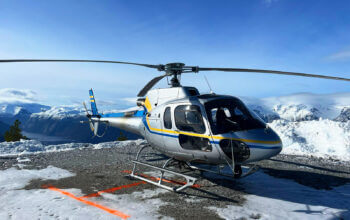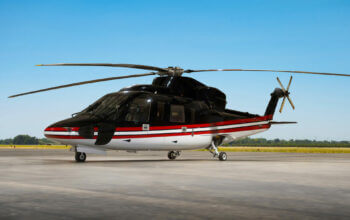Estimated reading time 10 minutes, 10 seconds.
When Sidhant Sharma first started along his path in aviation, he never imagined he would earn the title of being an aircraft maintenance engineer (AME) at Air Canada, and possibly even the world’s youngest Boeing 787 engineer. Sharma has been around aviation his whole life — from being in Air Cadets from a young age, to his father being a loadmaster for Japan Airlines, and his brother becoming an Airbus A320 first officer — but he was especially drawn to the often-overshadowed maintenance side of the industry.
“I did find the technical aspect of [aviation] pretty interesting,” said Sharma, “because you have to take such a methodical approach in order to resolve an issue within an airplane. It’s just the kind of person that I am, as well.”

While he didn’t have a lot of “hands-on experience” prior to attending the British Columbia Institute of Technology (BCIT) on a scholarship, Sharma took a full-time job working the ramp at Pacific Coastal Airlines during his first few years of school.
His biggest learning curve began when he graduated from his maintenance program in 2014, and made the leap from the ramp to maintenance at Pacific Coastal.
“It was a matter of simply putting my head down, working hard, listening to others, learning from my mistakes, and being modest,” said Sharma, “just to help me get through my apprenticeship.
“My apprenticeship was very interesting because that’s where I realized every job is an important job — there’s no such thing as a small or insignificant task,” he added. “Jobs like greasing landing gear or flight controls . . . they weren’t always jobs that would help me complete my logbook, but all the jobs would ultimately help build my character.”
His work ethic, collection of knowledge, and positive outlook — all of which are inspiring — helped him become an AME at Pacific Coastal, and soon after, in 2017, land a job as an AME at Air Canada. Though the Canadian flag carrier was only accepting new hires in Toronto, Ont., Sharma didn’t hesitate to travel across the country for the exciting opportunity.
“Being out in Toronto by myself… it did kind of test my ability to adapt to a new environment without having a support system,” he said.
Sharma was making impressive career strides at such a young age. “I actually joined the airline a day after my birthday, I just turned 23.”
And another achievement followed one year later. In 2018, Sharma completed an endorsement course on the Boeing 787 — which was a relatively new plane at the time. At 24 years old, Sharma believes he might have at one point been the youngest 787 engineer in the world.
“Only Boeing was doing the endorsement courses [at the time], there were no thirdparty courses,” explained Sharma. “So the same instructors would go around the world to all the different airlines to do these 787 courses. One of the instructors told me, during sim training, that I was actually the youngest person they’d taught thus far. He basically said, ‘…making you the youngest 787 engineer in the world.’ It’s not written in stone or anything, but it was a pretty cool thing to hear.”
Reflecting on that moment, Sharma said he felt rewarded for his persistence. Not to mention, it was a true “full circle moment” for him from where he started.

“In 2013, when I was at BCIT, we took a field trip down to the Boeing Seattle factory,” he recalled. “And that was the first time I saw the 787 up close. . . . And I just said to myself, ‘Hopefully I’ll work on one of these one day.'”
Later in his career at Air Canada, Sharma worked his way up to relief team leader for the Vancouver base, which provided him the opportunity to learn the operations behind the maintenance department. “It was a great experience because I was able to see the bigger picture, and how all the different departments (operations control, planning, ground operations, [and] flight operations) come together to achieve the common goal of getting the aircraft ready for departure,” he said.
Since the COVID-19 pandemic hit, Sharma has been laid off from Air Canada.
But that hasn’t stopped him from pushing himself to further his career as an AME. “I feel very blessed because I did get a lot out of [Air Canada] in terms of growth and advancing my career.”
Now, he’s paving his own path as the founder of AOG Solutions Inc., which has allowed him to do contract AME work for companies in the Vancouver, B.C., area.
“One thing about being an AME that people don’t think about is you have the ability to contract,” said Sharma. “So AOG Solutions is an incorporated company that I set up, and it allows me to work for other AMOs.
“You get to utilize your transferable skills and apply the sum of your knowledge to the work. . . . It’s just a matter of constantly pushing myself to build knowledge, and not getting too comfortable. Being able to learn and adapt to these different environments is really what helps me become more well-rounded.”
Sharma stressed that the work of an AME is much more diverse than many might think. “The greatest misconception about AMEs is that we just change tires,” he laughed. “But there are three categories of AMEs. There’s avionics, structural, and maintenance.”
Sharma is a maintenance AME, which means he’s able to do troubleshooting and repairs on the full scope of an aircraft. For example, “If the windshield gets damaged from a bird strike, you’re replacing the windshield. Or if one of the engines is lagging and the other one is too quick to react, then you’re adjusting the controls of the engines.”
While the maintenance side of aviation is often overshadowed by the pilot/crew side, Sharma said he encourages young people who are interested in aviation to take the AME path. “It does take a special level of diligence and attention to detail to be an AME,” he said, “but it’s extremely rewarding.
“And a lot of smaller operators are still hiring, like flight schools and other companies in general aviation,” he added. “I’d highly recommend that because you get to build a lot more diverse skills and develop a strong foundation starting out with the smaller companies, like I did.”
His advice for current or aspiring AMEs comes from a quote he heard growing up that has stuck with him: “Don’t chase success, chase excellence and success will follow.”
“I did that,” he said. And there’s no limit to what he’ll achieve next.









THANK YOU Skies Magazine for providing this article which focused upon this superb young man, his talents and career. But above all, the exciting and rewarding careers available in the technology of Aircraft Maintenance. You are correct, Technicians, Engineers and the profession of Aircraft Maintenance are so often ‘overlooked’ as an integral part of the aviation & aerospace industry. Well done!
AMEs in Canada have been portrayed as simply being “Mechanics” since the day that the Canadian Air Board issued their First Regulations back in 1920 – which is in part why John Charles Clifford was unable to identify why AMEs should be anything more than a technician and not a legal representative of the Crown as a delegate of the Minsiter of Transport in his 1985 Law Reform Society report “Inspection, A Case Study”. I contacted Mr. Clifford, who practices Law in Toronto a few years back and shared with him new information obtained from various libraries etc on the origin on the AME in Canada and their legal status and he informed me that since that report was written and submitted i was the only person to have contacted him and that he had expected that his report would have raised discussion and investigation into the subject a lot sooner. While AMEs in general are good if not excellent “Mechanics” the license they are issued by the Federal Government of Canada stems from “Regulations” prior to 1920 and is intended to be that of an “Inspecting & Certifying Engineer” . The legal requirement for AMEs stems from the Aeronautics Act which necessitates that aircraft be inspected for safety and that a person or class of persons may be delegated this task as the Governor General – and the Minister of Transport – are unable to be everywhere in Canada to personally accomplish this legal requirement whenever aircraft are being maintained. In Fact, the AME’s were in existence within Canadian Legislation PRIOR to the organisation and certification of the Provincial P.Eng associations. Sadly, since so much effort was done to portray the AME as a simple mechanic, this mentality has managed to insinuate itself in all levels of knowledge today and yet, after an incident or accident, when the smoke clears and debris settles it is often the Licensed AME whose signature is in the technical records that remain who is the focus of the investigation … Sadly after the issue of the Moshansky report – in which Justice Moshansky states “The AIRs need to be supported” (AIRs being Airworthiness Inspection Representatives – and the Original acronym for AMEs in Canada) the changes that were made did not support the “inspection and certification” aspect of the AME License and its’ required education, but instead the focus shifted to train AMEs to be better “Mechanics” more in line with the American FAA A&P license holder when in fact the Licensed AME’s role in Canada was originally intended to be akin to that of the American A&P who meets the requirements and is issued with an I.A certificate. Sadly there are a great many who feel that the Licensed AME in Canada should be nothing more than a “technician” or “mechanic”. Unfortunately for the new post 1996 “Aircraft Mechanic AMEs” the provinces never initiated a full and effective trades training and qualification system to certify these apparent “Trades – Persons” in the individual provinces, so unlike every other TRADE in Canada that has Provincial requirements on the training and subsequent independent certification of “Trades-People” it is left up to the Colleges in Canada that educate the students as “Aircraft Technicians” to attest to their 100% competence as “trades-persons” upon graduation, and without these graduates having completed their apprenticeship prior to their writing their Transport Canada CARs examinations and being issued with an AME License if they pass their CARs exam …. Sadly today’s apprentice AMEs, without a proper provincial trades’ qualification process to ensure they are fully capable of performing their work and only passing a CARs examination now truly at the mercy of any who come at them once they attest their signature to any aircraft document.
I want to reach out to Sidhant Sharma for inquiries and help with planning my future just like him. Can I have his contact or email?